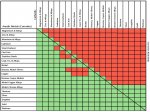I tackled this last night. Soup to nuts, took about 3 hours. My 803 is a 2000 non-reset unit, so most of the nuts are not caged. I went ahead and installed rivnuts, which led to a little extra work that is not necessary to complete the fuel line repair. Here is some of what I did:
1. remove all of the bolts from the rear panel to get access to the fuel tank to remove/connect the old/new fuel return line
- the bolts along the bottom have nuts on the back side, all other nuts are caged
2. remove all of the bolts from the top cover
- all bolts going into the radiator area are caged
- most others came off using an light weight impact driver and holding the nut with my fingers
3. remove front top cover to get access to the support that the front and rear top cover mount to
- there are only about 10 bolts to get this off, one of them is caged, the rest are bolt and nut
- the panel cover has to come off and most of the screws broke off while attempting to remove them
With all of these covers off, locating and removing the fuel return line is easy. My old fuel line pulled apart and came out easily. Getting the old hose off of the Tees required a little more effort, though. I simply took the section of Tees out as a whole line, and rebuilt it on my workbench using the 3.2mm gates hose. The hose was rather tight and I used some WD-40 to lubricate the ends while reassembling. I also had to use a towel and a air of pliers to hold and twist each piece to a secure connection. No hose clamps are required. Once pieced together, I strung the new Tee section back on top of the engine and, using WD-40 again, was able to put the hose onto the return barbs. After getting all the hose connected, I fired up the generator and watched for 5 minutes to verify that there were no leaks.
With all of the panels off, I was easily able to install the rivnuts. I used Astro Pneumatics 1442 rivnut setter, with a 10-32A mandrel to install the aluminum rivnuts. You will want to use aluminum rivnuts to avoid galvanic corrosion(dissimilar metals). For bolts, I reinstalled the original bolts as they are, I believe, plated to prevent galvanic corrosion. I stripped a few, and broke many of the screws that attach the control panel cover and will be replacing those with zinc plated 10-32 bolts/cap head screws. From what I've gathered, zinc has a lower instance of galvanic corrosion with aluminum, and the plating prevents the steel from contacting the rivnut.
When installing the rivnuts, I found that installing the rivnut on the tool fully would make it easy to over-pull the rivnut, essentially stripping out the treads. The easy fix is to thread the rivnut onto the mandrel until only a few threads are still uncovered. This limits the full pull of the tool and still creates a strong bond on the rivnut. It did take some trial and error, but I had the process down after the third one. There were a handful of places where I could not install a rivnut due to the mounting hole interfacing with multiple panels, most notably on the front top cover, in which laces I simply reinstalled the bolt and nut.
All said and done, from disassembly to fully reassembled, I finished this project in roughly three hours. I had put it off for fear of the hundreds of nuts and bolts that would be impossible to reach. After going through it, it is perhaps 40 total nuts and bolts to attack, many of the nuts are caged and therefore not a real problem. I suspect going back with nuts and bolts would have taken much longer than using rivnuts, though. The 1442 tool is overkill for aluminum 10-32 rivnuts, and you can easily strip them out, but it is easy to learn how to do it properly. I have other uses for the tool with larger rivnuts, so that is why I went with it. If you are just wanting to install rivnuts on your MEP, you should be able to get by with either a cheaper, lighter-duty, setter, or just use the bolt/nut/lockwasher method which is well documented in numerous youtube videos.



